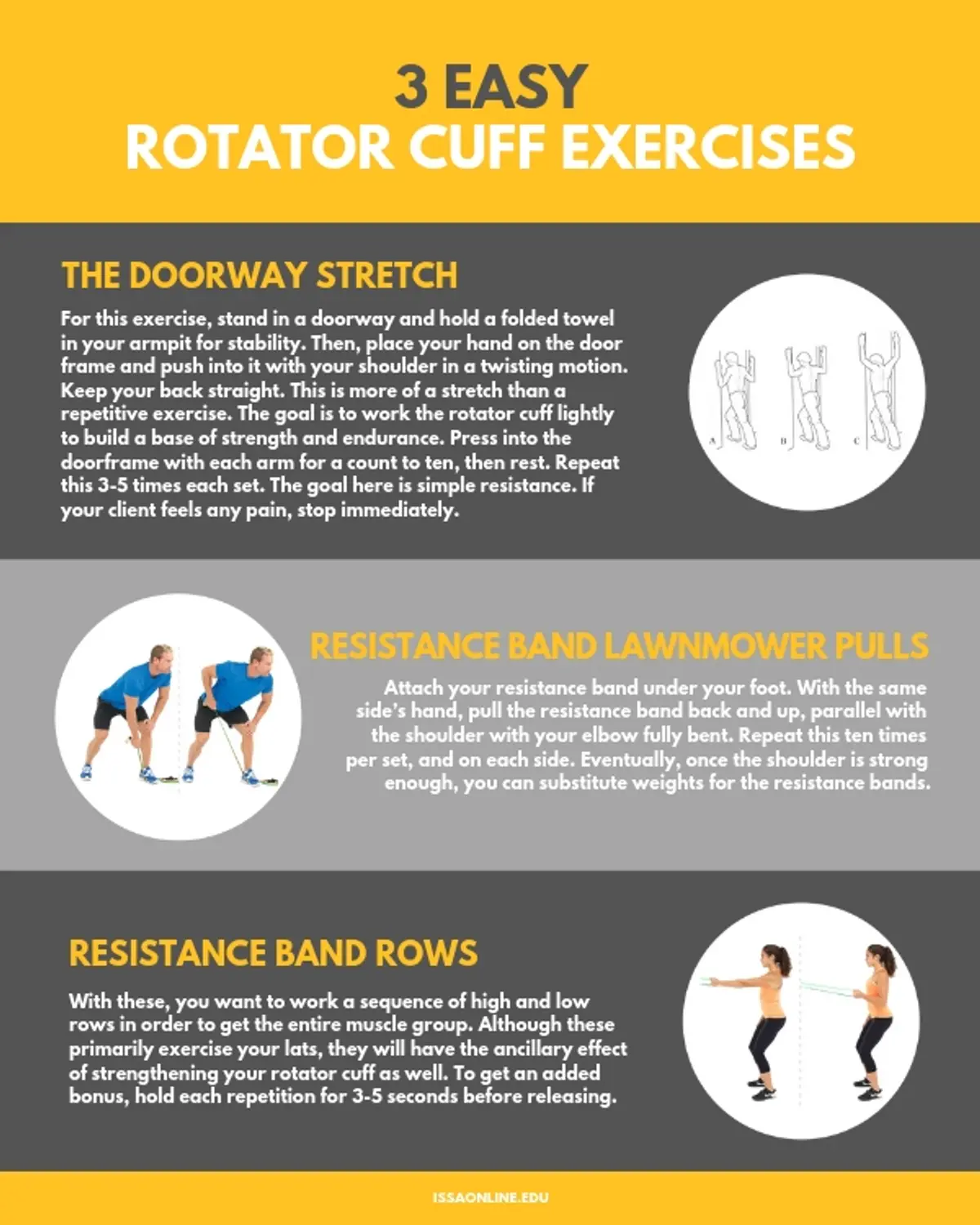
Shoulder Exercises to Reduce Injury
Reading Time: 5 minutes 5 seconds
BY: ISSA
DATE: 2019-10-11
The shoulder is one of the most critical musculoskeletal formations in the body. Essential for most of the things we do in our day-to-day lives, from minor things, like drinking from a cup or opening doors, to the big things like picking up your kids or carrying a bag, the shoulder's importance is paramount. Pushing, pressing, and general rotation are the order of the day, and nearly every movement we use with our hands and arms impacts the shoulder.
Unfortunately, this also means that the risk of injury to this grouping of muscles, ligaments, and bone can be high with certain exercises. Shoulder mobility is so important that it's prudent for trainers to consider injury prevention in their approach to programming for clients. If clients are injured, they cannot train and you cannot earn, two aspects which demonstrate how essential it is to consider wear and tear in your plan.
For this article, we'll be taking a deep dive into shoulder exercises helpful to reduce injury, as well as how to ensure you don't get injured to begin with. So, let's dig in!
Common Shoulder Problems
Often times, shoulder issues are overuse injuries. Some problems surround the muscles in the shoulder, whereas others are actually about the joint connections themselves. Pain levels will vary from person to person. The key is understanding what the individual is facing. However, make sure you are not trying to diagnose the issue for your client. It's extremely important that, as personal trainers, we understand that we are not medical professionals. Have your client check with a doctor before trying any program following any repetitive strain injuries.
Knowing what causes these issues, though, can help you to prevent them in your client. Knowing their history is definitely part of our job, and it's financially important as well — injured clients might have to stop training.
One of the more common shoulder injuries occurs with the rotator cuff. Rotator cuff injuries are most often caused by overhead repetitive motions, often in conjunction with manual labor or sports[1]. The humerus being forced out of the socket joint, or glenoid, is the root cause of shoulder instability, and this is usually the effect of some sort of trauma to the joint, as opposed to overuse.
Going More In Depth
The main scapular and general shoulder muscles affected are as follows:
Supraspinatus: Connects the shoulder blade to the rotator cuff
Infraspinatus: Allows the rotator cuff to rotate externally and stabilize the shoulder as a whole
Subscapularis: Rotates the head of the humerus medially
Deltoid: External muscle performing basic abduction and transverse abduction
There are a host of reasons why this muscle group might be hurting. A lot of the variations surround tendon issues, such as the bicep tendon or rotator cuff tendon. Swimmer's shoulder is a common problem with the shoulder. With this condition, there is a subacromial impingement caused by rotator cuff tendonitis. This is also known as a shoulder impingement more colloquially.
Generally speaking, any inflammation of muscles and tendons will cause pain. It's essential to pay attention to even small pains in the joint, as they can often grow to become much worse if left untreated. Shoulder tendonitis, an inflammation of the rotator cuff tendons, can be very uncomfortable, but the good news about this issue is that it's simply a matter of inflammation due to overuse[2], meaning that with rest and ice, it can be treated in a few weeks, depending on the physician's advice. Along with inflammation in something like the bicep tendon, take care, and try to avoid using these areas when affected.
Another common injury is adhesive capsulitis, also known as a "frozen shoulder." The connective tissue that encapsulates your rotator cuff can thicken and tighten the shoulder, preventing movement. The cause of this condition, though, remains elusive[3], so keep an eye out for it in your clients as it can seemingly come without cause.
Injury Prevention
First and foremost, you must know the injury background and training history of your client. For instance, if they have suffered an injury in the past, you want to modify exercises. The bench press is a common tool in a personal trainer's inventory, yet is isn't always necessary. And, it isn't simply a matter of weight. A person can get injured just as badly by doing too many reps with low weight as they can be with trying to do individual heavy lifts. For those with shoulder injuries, it's usually best to find other exercises to strengthen the supporting muscles before attempting bench presses and overhead presses.
But what about people who have never had a shoulder injury? Well, it's still advisable to start off very gently. Make sure that the exercise program you put together is a progression over time. The urge to improve quickly is often what causes the first shoulder injury. As such, make a concerted effort to start small and only add weight and repetitions as the client demonstrates improved aptitude. One of the best ways to ensure that shoulders strength grows before even touching a weight is by focusing on bodyweight exercises like pushups. If the client cannot start with several sets of regular pushups, then modify the exercise on the wall, or modify the exercise onto the knees in order to develop a base of strength in the shoulders and pectoralis muscles before diving into free weights.
For older clients, you really want to be even more cautious. For clients who are older adults and baby boomers, it's even advisable to start them off with resistance bands until you have more confidence in their ability. Resistance training is very beneficial to this population, but only so long as it's performed in a safe manner.
Strengthening the Rotator Cuff
There are many strengthening exercises you can perform that can help with injury prevention specifically in regard to the rotator cuff. The key here is focusing on actions that will add resistance without putting too much stress into the joint itself. Think more in terms of stretching and light band exercises.
Think first about on mobility without pain. Only after you can execute a full range of motion without pain should you consider adding resistance. But again, it's essential to stress that you must instruct your clients to get a doctor to sign off on anything should there be a history of problems or pain in the shoulder.
Then, when you're ready, you can use some of the exercises in the downloadable handout for focusing on strengthening the joint region.
For effective recovery after working out the shoulders, check out this article on relieving tight muscles in the neck and shoulders.
After an Injury
Unfortunately, following a shoulder injury, a person will need physical therapy and a robust rehabilitation program. This is out of the scope of a personal trainer's practice, so make sure to refer your client to a medical professional.
Then, once they have been approved for working out with you again, try to communicate with their physical therapist to get a sense of their range of motion, special considerations, and anything else that will benefit them during recovery.
Want to help clients prevent muscle-related pain or movement limitations? Learn how to identify and correct the most common movement dysfunctions with the ISSA's Corrective Exercise course.

Click HERE to download this handout and share with your clients!